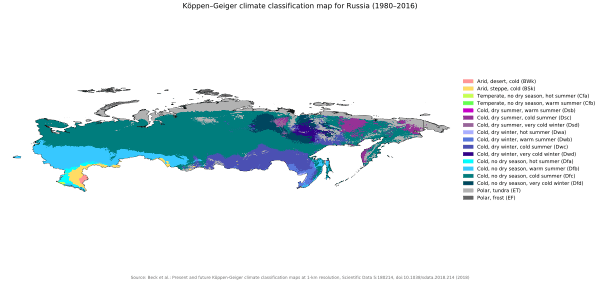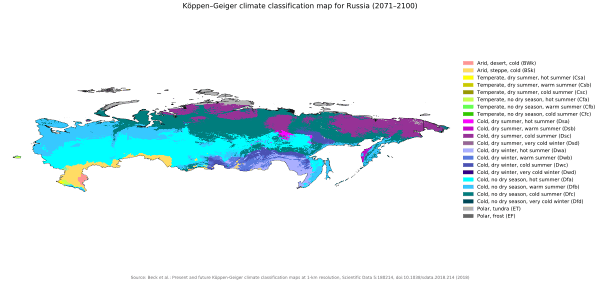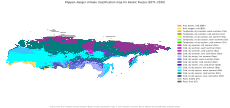Climate change in Russia
Climate change in Russia is the global warming-related issues in Russia. This includes climate politics, and the influence of global warming in Russia. In September 2019, Russia announced that it will implement the 2015 Paris Agreement to fight climate change.[1]
Agreements
Kyoto protocol
Russia ratified the Kyoto protocol in November 2009.[2] It came in force on 16 February 2010. This agreement did not cause emission cuts for Russia due to an earlier drop in emissions compared to year 1990 for other reasons, mainly a significant drop in economic growth.
Effects of climate change on Russia
IPCC
According to IPCC (2007), climate change affected temperature increase which is greater at higher northern latitudes in many ways. For example, agricultural and forestry management at Northern Hemisphere higher latitudes, such as earlier spring planting of crops, higher frequency of wildfires, alterations in disturbance of forests due to pests, increased health risks due to heat-waves, changes in infectious diseases and allergenic pollen and changes to human activities in the Arctic, e.g. hunting and travel over snow and ice. From 1900 to 2005, precipitation increased in northern Europe and northern and central Asia. Recently these have resulted in fairly significant increases in GDP. Changes may affect inland flash floods, more frequent coastal flooding and increased erosion, reduced snow cover and species losses.[4]
Permafrost
Permafrost is soil which has been frozen for two or more years. In most Arctic areas it is from a few to several hundred metres thick. Permafrost thawing may be a serious cause for concern. It is believed that carbon storage in permafrost globally is approximately 1600 gigatons; equivalent to twice the atmospheric pool. Protecting peatlands from drainage and clearance slows down the rate of greenhouse gases and gives benefits for biodiversity.[5]
Thawing of permafrost soils releases methane. Methane has 25 times the warming potential of carbon dioxide. Recent methane emissions of the world's soils were estimated between 150 and 250 million metric tons (2008).[6] Estimated annual net methane emission rates at the end of the 20th century for the northern region was 51 million metric tons. Net methane emissions from permafrost regions north included 64% from Russia, 11% from Canada and 7% from Alaska (2004). The business-as-usual scenarios estimate the Arctic methane emissions from permafrost thawing and rising temperatures to range from 54 to 105 million metric tons of methane per year (2006).[6]
Thawing permafrost represents a threat to industrial infrastructure. In May 2020 thawing permafrost at Norilsk-Taimyr Energy's Thermal Power Plant No. 3 caused an oil storage tank to collapse, flooding local rivers with 21,000 cubic metres (17,500 tonnes) of diesel oil.[7][8] The 2020 Norilsk oil spill has been described as the second-largest oil spill in modern Russian history.[9]
Wildfires
According to IPCC, higher temperatures may increase the frequency of wildfires.[4] In Russia, this includes the risk of peatland fires. Peat fire emissions may be more harmful to human health than forest fires. Scientists alarmed by the peat fires in Indonesia in 2004 concluded that "burning peat could be a major contributor to the as yet unexplained accelerating build-up of CO
2 in the atmosphere since 1998." In October 2004 in Borneo, regionally the atmosphere was covered in thick smoke, visibility was 100 metres, schools shut and flights were cancelled.[10]
According to Wetlands International the wildfires in Moscow July 2010 were mainly 80–90% from dewatered peatlands. According to UN dewatered bogs cause 6% of human global warming emissions.[11] Moscow air was filled with peat fire emissions in July 2010 and regionally visibility was below 300 metres.[12]
Greenhouse gas emissions
Energy from fossil fuels
Most emissions are from the energy sector burning fossil fuels.
According to the research obtained by the Russian Science Foundation in 2019, concluded that the natural influx of greenhouse gases from terrestrial ecosystems in Russia constantly change. Measuring these influxes had shown that greenhouses gases into the atmosphere in short time intervals is contributing to the deceleration of warming in Russia. This is attributed to the fact that the effect of temperature growth deceleration, due to absorption of CO2 by the terrestrial ecosystems from the atmosphere, is stronger than the effect of warming acceleration caused by the emission of CH4 into the atmosphere.
The effect of terrestrial ecosystems contributing to the deceleration of global warming in the Russian regions grows in the first half of the 21st century and decreases by the end of the century upon reaching the maximum, depending on the scenario of anthropogenic emissions, under all studied scenarios of anthropogenic impacts resulting from the growth in natural emissions of CH4 and the decrease in CO2 absorption by the terrestrial ecosystems. In accordance with the results obtained, under the scenarios of anthropogenic emissions considered, the natural emissions from the Russian regions will also accelerate climate warming on the short time horizons under the climate conditions of the second half of the 21st century.
Deforestation
Russian challenges for forests include control of illegal logging,[13] corruption, forest fires and land use.
Present and future Köppen-Geiger climate classification maps






See also
References
- "Russia gives definitive approval to Paris climate accord". Reuters. 23 September 2019. Retrieved 25 September 2019.
- "ENTRY INTO FORCE OF KYOTO PROTOCOL, FOLLOWING RUSSIA'S RATIFICATION, HISTORIC STEP FORWARD TO COMBAT GLOBAL WARMING, SECRETARY-GENERAL SAYS IN NAIROBI | Meetings Coverage and Press Releases". www.un.org. Retrieved 31 January 2020.
- UNEP Year Book2008, An Overview of Our Changing Environment Archived 1 April 2016 at the Wayback Machine, United Nations Environment Programme 2008 pages 2
- IPCC Working group III fourth assessment report, Summary for Policymakers 2007
- The Natural Fix?: The Role of Ecosystems in Climate Mitigation UNEP 2009 page. 20, 55
- Year Book2008, An Overview of Our Changing Environment Archived 1 April 2016 at the Wayback Machine, United Nations Environment Programme 2008 pages 38–41
- "Diesel fuel spill in Norilsk in Russia's Arctic contained". TASS. Moscow, Russia. 5 June 2020. Retrieved 7 June 2020.
- Max Seddon (4 June 2020), "Siberia fuel spill threatens Moscow's Arctic ambitions", Financial Times
- Ivan Nechepurenko (5 June 2020), "Russia Declares Emergency After Arctic Oil Spill", New York Times
- Massive peat burn is speeding climate change, New Scientist 6 November 2004, Fred Pearce
- turvesuot liekeissä talveen asti yle 12.8.2010
- Venäjän metsäpalot tukaloittavat moskovalaisten elämää yle 26 July 2010
- Welle (www.dw.com), Deutsche. "Russia's forests threatened by illegal logging | DW | 25.03.2019". DW.COM. Retrieved 29 October 2019.